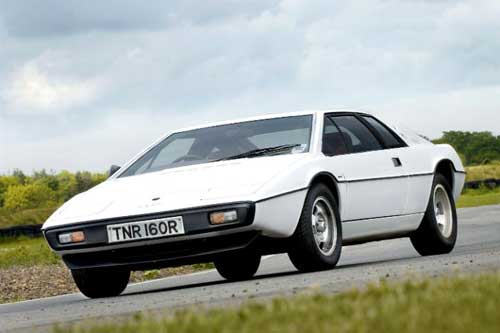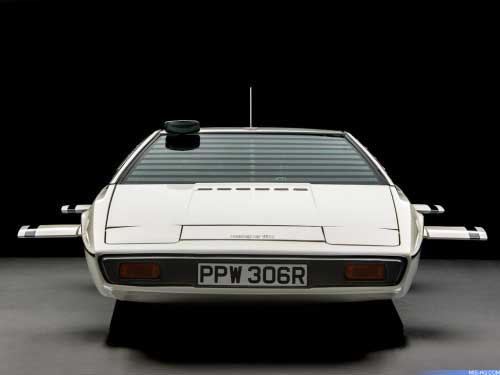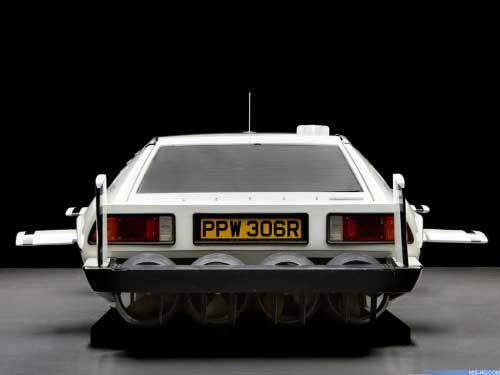
James Bond's Lotus Esprit driven
It's known the world over for its ability to turn into a submarine – at least in the movies. Andrew Frankel drives the Lotus Esprit Series I

From the moment Jimmy hits the gas to the moment the Lotus hits the Med adds up to barely 3 ½ minutes of screen time. But they are unquestionably the best remembered 210 seconds of any Bond film of the Roger Moore era, for it was here in The Spy Who Loved Me that director John Glen appears to have decided to pile every single item of Bondian iconography, resulting in the best car chase in 007 history.
There are gadgets and one liners galore, not one but two beautiful women, explosions, death, and every form of transport from a helicopter to a motorcycle with a lethal, rocket-propelled side car. But what do we remember most? The car of course, the white Lotus Esprit. This not only got Bond back in his first proper British sports car since Goldfinger’s Aston Martin DB5 but, for the first time in a Bond film, it was actually driven properly.
You have Roger to thank for that. That’s Lotus development engineer Roger Becker rather than Roger Moore, the Bond who at times seemed to have trouble controlling his own eyebrows, let alone a mid-engined supercar. Becker was originally tasked simply with delivering the Esprit to Sardinia for filming.
Once it was there, however, the professional stunt driver couldn’t get the most from it, so when the increasingly frustrated director called for it to be delivered to its next location, Roger drove up the hill like only Lotus’s finest test driver could. He spent the next seven weeks doubling for the other Roger in every action scene to feature the car, at least before it turned into a submarine.
James Bond's Lotus Esprit submarine
But was the Esprit really suitable transport for Bond to outwit, outrun and outgun the bad guys? Drive an early Esprit today (the film car was the original Series 1 model) and once you’ve gasped at its dreadful Morris Marina door handles and ancient Land Rover switchgear and fired it up, the next thing you’ll notice is that it’s not very fast.
Its engine displaced just 2.0 litres and was still some years away from gaining a turbocharger. Its 160bhp output is less than you’ll find in a top-of-the-range Fiat 500 today and even though it only weighed about a tonne, Bond was lucky Jaws had nothing more potent than a Ford Cortina – and yes Bond geeks, it was indeed technically a Taunus – in which to chase him.
Even so, it’s an error too often made to mistake fast for fun. The Esprit might have struggled to reach speeds treated with contempt even by fast hatchbacks today, but if you cared about driving in its purest, most essential form, this might just be the greatest car ever to be sat in by a secret agent.
Because it was so low, so light and so exquisitely designed by a team led by Colin Chapman, undoubtedly the greatest British automotive engineer of his era, as a driving machine the Esprit was and remains, simply, utterly and relentlessly wonderful.
You sit low and reclined in a channel next to the transmission tunnel, as you might in a purpose-built racer. The engine might not be that powerful, but its sharp snarl and love of high revs still makes its noise an addictive presence in the car. But that’s not what the Esprit is really about.Remember that bit when Bond dives between two trucks with death-defying split microsecond precision? Capturing that shot must have been heaven on earth for Becker and something closer to black magic for the watching film crew.


I can remember driving an Esprit for the first time and goggling at the speed at which it would change direction. In corners it had far more grip than I had courage. That low stance and wide track coupled with Chapman’s suspension wizardry conjured up adhesion where all common sense said you really should be in the trees by now. Or the Mediterranean.
But there was a problem with those early cars which were so badly built I wasn’t at all surprised to see Bond dangle a fish out of the window as he drove out of the sea: it had probably swum in through the panel gaps. It was only when the Series III model came out in 1981 that Lotus even begun to get on top of the problems, though you’d hope by now that everything that was going to break on an early Esprit would have fallen off years ago and, hopefully, put back with rather greater care.
Even so, were I in the market for such a car I’d buy a Series I only for its visual purity. The engine expanded to 2.2-litres for the Series II, and while it gained no more power, it was considerably more flexible. But the Series III is the one to have, at least of those built before the car was extensively redesigned by Peter Stevens. These cars had better build quality, the bigger engine and, crucially the heavily revised suspension and far fatter tyres of the then new Esprit Turbo, but without its tiresome turbo lag and irritating noise.
If you’re in the market, however, don’t be romanced by the attractive body. Esprits never show rust to the naked eye, but underneath can be a very different story. Be aware too that years of not being worth very much have led to many being neglected. But those who buy with caution will bag themselves not just one of the best looking British sports cars of all time, but also probably the most focussed driving machine ever to make it onto the MI6 company car fleet.